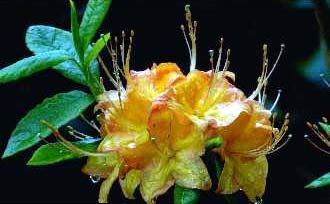A well-planned perennial bed of flowers and blooms provides a lively interest throughout the year. Its never-ending succession of colors constantly changing the face and personality of the garden.
In every season of the year, the showy perennial bed is garbed in different colors, textures, and forms: excitingly bright and radiant in spring, when bulbs dominate the awakening landscape; lush and elegant in summer, when towering, majestic flowery spikes hold sway; muted and harmonious in fall, when masses of blooming autumn perennials embrace the garden; decked with attractive accents in winter, when tufted grasses remain.
The bed that is described here is a rich combination of perennials and bulbs. No matter what the season, there is always something in bloom, always a different perennial to capture admiring glances. This bed contains an interesting assortment of plants in an area measuring 8 feet by 13 feet. Such a bed should be located near the house so its magnificence can be admired from indoors and as you come and go. A sunny exposure and loose garden soil are requisites for optimum results.
Colorful Spring Flowers
After the last snow has melted away, the garden slowly stirs to renewed life. Snowdrops poke their heads out of the ground, announcing spring's imminent arrival. Together with yellow leopard’s bane and red Kaufmann tulips, they team up to provide spring’s first color before narcissi and Darwin tulips pick up and accelerate the season's rhythm. Mat-forming aubrietas start to bloom at the same time as these early spring bulbs, steeping one side of the bed in a sea of blue flowers, while white perennial candytufts provide a lively foreground planting.
Summer’s Blooms
Peonies, with their large cuplike flowers, are the first perennials to mark the start of summer. They precede the radiant white and rich blue delphiniums, fire-engine red corn poppies, and showy pink, red, and white-and-red variegated phloxes. Bellflowers, Shasta daisies, scabiosas, avens, and graceful Madonna lilies intermingle their delightful colors and forms. The lively green clumps of maiden grass, their towering plumed spikes tossed by summer breezes, provide a peaceful, harmonizing note to these riotous colors. If these showy perennials are cut back after their first flowering, almost all of them will return for another late-summer bloom.
Fall's Golden Glow
Garden phlox continues to bloom until early fall. Golden-eyed heliopsis and reddish brown clumps of switch grass and violet asters now lend their more muted hues to the reds and pinks of the bed. Rudbeckias and delphiniums rise, one more time, to provide a final short-lived breath of summer color to the bed before autumn's somber shades take over and bid farewell to the growing season. From this moment on, ornamental grasses provide garden beauty all winter long.
Caring for the Bed
In spring, all faded blooms must be regularly removed from the bulb plants in the bed. Their foliage, however, must be allowed to stand and must not be cut back until after the leaves turn yellow. Before the perennials have put forth foliage, the soil around them should be loosened, weeds should be pulled out, and an all-purpose fertilizer may be applied to the bed. Be sure plants get enough water during summer. Remove faded flowers regularly; that stimulates new flowering and keeps the bed neat. Only in fall will you need to devote a little extra attention to the bed, as your perennials will need to be prepared for winter. Pruning and rejuvenation every 4 to 5 years is particularly important for a number of them. In the fall, you can work a little compost into the soil to make up for nutrients that have been depleted from it.
Rhyme and Reason
Always keep in mind that a few well-chosen combinations of plants are better than many planted at random. Too many colors and too many combinations of flowers will give the bed a jumbled look, and in the overabundance of plants many will fail to be appreciated.
In laying out a perennial bed, start with the most important perennials first - with shrubs, for example, which will form the framework for the bed as a whole. Mass-flowering plants such as asters, mat-forming perennials such as aubrietas, and the gap fillers such as snowdrops are the last to be incorporated. Thoroughly prepare the soil before planting. Distribute all your plants first so you will get an idea of their combined effect. You will still have time to rearrange a few, if necessary.
TIPS: DIVISION REJUVENATES FLOWERING
Many showy perennials decline, over time, in flowering vigor. Mat-forming perennials like bellflowers, aubrietas, and candy-tufts turn leggy and barren at the center; chrysanthemums, phlox, and heliopsis develop into messy bushes and flower sparsely. Divide such plants every couple of years; replanted, the divided segments will regenerate themselves quickly and bloom robustly again.
A Suggested List of Plants for a Perennial Garden:
1 peony (Paeonia lactiflora 'Avalanche' or other white cultivar)
1 scabiosa (Scabiosa caucasica 'Clive Greaves')
1 rudbeckia (Rudbeckia fulgida 'Goldsturm')
1 poppy (Papaver orientale 'Beauty of Livermere')
1 leopard's bane (Doronicum cordatum 'Spring Beauty')
1 heliopsis (Heliopsis scabra 'Golden Plume')
1 maiden grass (Miscanthus sinensis 'Condensatus')
2 Shasta daisies (Chrysanthemum X superbum 'Alaska')
2 asters (Aster novi-belgii 'Marie Ballard')
3 delphiniums (Delphinium hybrids 'Galahad', 'Summer Skies', and 'Astolat')
3 phloxes (Phlox paniculata 'Dresden China', 'Fairy's Petticoat', and 'Dodo Hanbury Forbes' or other combination)
3 bellflowers (Campanula carpatica 'Blue Clips')
3 avens (Ceum coccineum 'Fire Opal')
3 perennial candytufts (Iberis sempervirens 'Snowflake')
3 switch grasses (Panicum virgatum 'Haense Herms' or 'Rehbraun')
5 aubrietas (Aubrieta 'Cascade Strain' or other cultivar)
Bulbs for perennial blooms to provide early spring color:
5 snowdrops (Calanthus nivalis)
5 Kaufmann tulips (Tulipa kaufmanniana 'Showwinner')
7 Darwin tulips (Tulipa 'Elizabeth Arden')
10 poet's narcissi (Narcissus poeticus 'Actaea')
7 trumpet narcissi (Narcissus 'Golden Harvest' or another yellow cultivar)
3 Madonna lilies (Lilium candidum)


